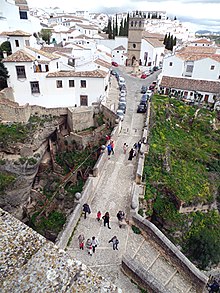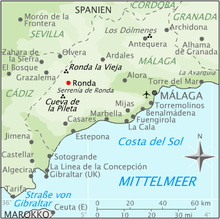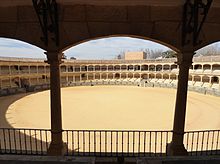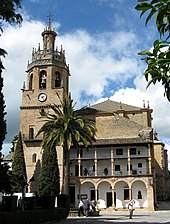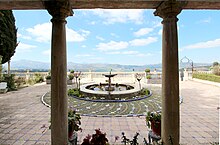Ronda
| Ronda municipality | ||
|---|---|---|
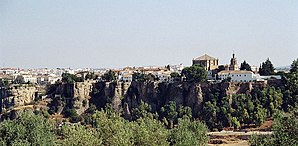
|
||
| coat of arms | Map of Spain | |

|
|
|
| Basic data | ||
| Autonomous Community : | Andalusia | |
| Province : | Málaga | |
| Comarca : | Serrania de Ronda | |
| Coordinates | 36 ° 44 ′ N , 5 ° 10 ′ W | |
| Height : | 723 msnm | |
| Area : | 481 km² | |
| Residents : | 33,877 (Jan 1, 2019) | |
| Population density : | 70.43 inhabitants / km² | |
| Postal code : | 29400 | |
| Municipality number ( INE ): | 29084 | |
| Nearest airport : | Málaga ( Aeropuerto de Málaga , 65 km ) | |
| administration | ||
| Official language : | Castilian | |
| Mayor : | Antonio María Marín Lara ( PA ) | |
| Website : | www.ronda.es | |
| Location of the municipality | ||
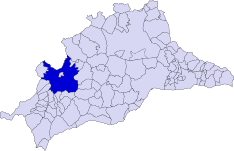
|
||
Ronda is a city in the Andalusian province of Málaga ( Spain ). It is located at an altitude of 723 m above sea level in a mountain landscape known as Serranía de Ronda , which also includes the Sierra de Grazalema and Sierra de las Nieves natural parks . The city is located around 113 km west of the provincial capital Málaga and 50 km north of the Costa del Sol .
With 33,877 inhabitants (as of January 1, 2019), called Rondeños , and an area of around 480 km², the municipality of Ronda is one of the largest towns among the “ white villages ” of Andalusia.
Geography and economy
Ronda is best known for its location: the Moorish old town, La Ciudad , is located on an all-round steep rock plateau. The old town is separated from the younger part of town, El Mercadillo , by a 100 m deep gorge called the Tajo de Ronda , formed by the Río Guadalevín . The abyss is spanned by three bridges: the Puente Árabe ("Arab Bridge"), the Puente Viejo ("Old Bridge") and the most famous, the Puente Nuevo ("New Bridge") , built in the 18th century .
The city's economy today is largely geared towards tourism . Thousands of day visitors flock to Ronda from the resorts on the Costa del Sol every day . There are also companies that process agricultural products and traditionally also manufacture furniture.
climate
The average annual temperature is 15 ° C , with 2,700 hours of sunshine and an annual rainfall of 648 l / m². The Spanish fir (also known as hedgehog fir ) ( Abies pinsapo ) is endemic to the mountains around Ronda .
history
Early history
The earliest traces of settlement in the region date back to the Paleolithic Age . About 20 km southwest of the city is the Cueva de la Pileta , a 2 km long cave with cave paintings dating back to between 18,000 and 15,000 years BC. Were dated. While these paintings mainly depict animals ( goats , horses , fish etc.), there are more recent paintings from the Neolithic Age , around 5000 BC , in other areas of the cave . BC, showing more geometric and abstract figures. In the 1st millennium BC Chr. Settled Iberians and Celts in the region, which also trade relations with the Phoenicians and Greeks talked.
Roman Empire
The first recorded name for the village comes from the Romans : Arunda , which is mentioned in their writings by both Pliny the Elder and Ptolemy . 132 BC BC Scipio the Younger had a fortified structure built. The most important city of the Romans in the region was not Arunda , but Acinipo , about 20 km northwest , which can still be visited today as a Roman ruin, including an amphitheater for 2000 people. During the civil war in Rome at the beginning of the first century BC The general Quintus Sertorius had Arunda destroyed. In 45 BC In turn, a temple was built to commemorate Julius Caesar's victory over the brothers Gnaeus Pompeius the Younger and Sextus Pompeius . In 429, at the end of Rome's rule on the Iberian Peninsula , Acinipo was destroyed. And even Arunda was finally plundered, despite the supposedly impregnable location on the rock plateau.
Around the middle of the 1st millennium, the Vandals , Alans and Suebi, who immigrated together, conquered the country as part of the migration of peoples , but were soon expelled by the Visigoths , allied with Rome . In 549 the Byzantines managed to reoccupy the south of the Iberian Peninsula for a short time. After driving out the Byzantines, the Visigoths destroyed the city that is now known as Ronda la Vieja , the "old Ronda".
Al-Andalus
At the beginning of the 8th century, coming from North Africa, the Moors invaded the Iberian Peninsula. In 713, two years after the start of their conquests, Abd al-Aziz , the governor of Al-Andalus , occupied the former Arunda and had a castle built on the ruins of the Roman fortifications. Ronda became the capital of Takorunna , one of the five administrative districts ( Koras ) into which Al-Andalus was divided.
The Moorish Al-Andalus (711 to 1492) was not a continuous and unified empire. While Moorish armies sometimes advanced as far as the Pyrenees , attempts by the Visigoths, who had been pushed back to the north of the peninsula, soon began to recapture Hispania . Also among the various Moorish peoples, such as the Arabs and the Berbers , there were finally disputes, in the course of which the power relations in Ronda changed again and again. When the Caliphate of Cordoba was divided into a series of rival kingdoms ( Taifas ) in the 11th century , Abú-Nur came to power in Ronda . He founded the kingdom of the Banu Ifrán , which roughly corresponded in size to the earlier Takoronna. The capital was renamed Madinat Ronda during this time and the city's defenses were expanded. His son and successor, Abú Nasar, was murdered on behalf of the king of the Taifa of Seville , with which Ronda, like Arcos de la Frontera and Morón de la Frontera, fell to Seville.
In 1086 the kings of the Taifas called on the North African Almorávids , Orthodox Sunni Berbers from what is now Morocco and Algeria , to help them fight the Christian kingdoms in the north. The struggle was largely successful, but the Almorávids, in whose eyes the Taifa kingdoms were too decadent and too little orthodox, now took over power in Al-Andalus (1090/1091) themselves. Their rule lasted barely a hundred years. In 1147 the Almohads conquered , after they had already conquered the whole of Northwest Africa (today: Morocco, Algeria, Tunisia, see also: Maghreb ), also Al-Andalus.
In 1212 there was finally a decisive battle between the Christian armies and the Almohads at Las Navas de Tolosa , in which the Moors were defeated. As a result, only the Nasrid Kingdom of Granada remained as the last Islamic empire on the Iberian Peninsula. Ronda was one of the westernmost cities of this empire and thus both an important border town and a trading center. In 1485, a year in which the Christians conquered a number of Moorish cities, they also took Ronda. The defenders were weakened, as much of the troops had withdrawn due to misinformation that Malaga was to be attacked by the Christian armies. After the besiegers had brought the city's water supply under their control, the defenders capitulated after several weeks of siege.
Spain
King Ferdinand II ("Fernando el Católico") granted the Moorish residents of the city free retreat, but they had to leave Ronda. Those who had arranged the surrender were taken to Alcalá de Guadaíra ( Seville Province ), where they were given the houses and lands of Jews that had previously been confiscated by Christians in the wake of the Inquisition . The houses and lands in Ronda were distributed among the Catholic conquerors. The last remaining Muslims were exiled in 1570 after attempting an uprising against the oppression of the new rulers. As the last witnesses of the Moorish rule in Ronda, in addition to the winding streets of the old town, the Baños Árabes (Arab baths), the Puente Viejo bridge , two palaces, Casa del Gigante and Palacio de Mondragón , and some smaller buildings remain, such as the former minaret Alminar de San Sebastián , which was converted into a Christian bell tower by adding one floor.
After the conquest of Ronda, the new inhabitants began with the extensive redesign of the city. Mosques were torn down and churches built in their place . Minarets were converted into bell towers. To the Moorish old town, now known as La Ciudad , a new district was added to the north beyond the El Tajo gorge: El Mercadillo ("the market"). In the south, the Barrio de San Francisco was built as an extension of the old town, originally a small market to avoid the taxes that had to be paid to bring goods to La Ciudad. In 1580 a severe earthquake shook the city and destroyed a whole series of structures, which were only partially rebuilt and in most cases replaced by new buildings.
The following centuries were a largely peaceful period for Ronda as the city continued to develop. Spain became a world power through the conquest of colonies, especially in Central and South America. However, Ronda remained of only regional importance and could not benefit from the Spanish colonial empire in America to the same extent as the port and trading cities of Cádiz and Seville . In the middle of the 18th century, two of Ronda's defining structures were built: the large bridge over the gorge between the old and new city, El Puente Nuevo ("New Bridge"), and the bullring . Also from the 18th century, three generations of the Romero family - Francisco, Juan and Pedro - all born in Ronda, developed the rules of modern bullfighting .
After Spain had lost most of its colonies in the 18th and early 19th centuries, thus also accounting for the income, and also suffered a series of severe military defeats in Europe, it was finally so weakened that in 1808, under pressure from Napoléon, his brother Joseph Bonaparte could ascend the Spanish throne. On February 10, 1810, his troops marched into Ronda, initially to rest there until spring. They stayed for two years and when they left they blew up the castle and parts of the city walls. Spain regained its independence in 1813.
As part of the Spanish civil war , the residents of Ronda tried to defend the republic against the Spanish putschists under General Franco . Nevertheless, fascist troops under General Eduardo Varela managed to take Ronda on September 17, 1936 using tanks. Republicans who were unable to flee to Malaga in time were sentenced to death in the following days. Some who had managed to flee led a guerrilla war against the dictatorship from the surrounding mountains until 1952.
On February 3, 1937, Franco troops under the command of Gonzalo Queipo de Llano from the vicinity of Ronda began their attack on Málaga.
While travelers came to Ronda in the 19th and early 20th centuries, including artists like Doré and Rilke, the city gradually became a tourist destination again from the 1960s onwards. In addition to the extraordinary location of the city on the rocky plateau, the importance of Ronda as the birthplace of modern bullfighting contributed to the city's attraction. Today, Ronda, along with the coastal regions and cities such as Seville, Cordoba and Granada, is one of the most important tourist destinations in southern Spain.
See also: History of Spain
| year | 1842 | 1877 | 1887 | 1900 | 1910 | 1920 | 1930 | 1940 | 1950 | 1960 | 1970 | 1981 | 1991 | 2001 | 2006 |
|---|---|---|---|---|---|---|---|---|---|---|---|---|---|---|---|
| Residents | 13,613 | 18,793 | 18,055 | 20,822 | 22,692 | 30,622 | 33.123 | 26,146 | 30,653 | 29,480 | 30,387 | 30,762 | 33,900 | 34,468 | 35,836 |
Culture
Bullfight
For Spaniards , Ronda is particularly important because of its role in the development of bullfighting . In the 18th and 19th centuries, three generations of members of the Romero family developed the rules by which fighting is still carried out today - from the use of the cloth, the fight of the torero no longer on horseback but on foot, to style and Poznan - known as Escuela Rondeña ("Ronda School").
Famous guests
In the 19th and 20th centuries, a number of international artists visited Ronda and sometimes spent long periods of time in the city, among them Gustave Doré , Rainer Maria Rilke (December 1912 to February 1913) and Ernest Hemingway (1923). In Hemingway's novel Whom the Hour Strikes , chapter 10 tells the story of the murder of the fascists in a small town who are pushed from the main square into a deep ravine. The description refers to actual events in Ronda during the Spanish Civil War .
Orson Welles spent a summer in Ronda at the age of 18 and was so impressed by the city, and especially by the bullfights, that his ashes were, as he wished, buried in a well on the Recreo San Cayetano estate three miles outside of Ronda. The actress Ava Gardner also lived in Ronda for a short time after her divorce from Frank Sinatra in the 1950s. In 1984 Francesco Rosi filmed the opera Carmen with Julia Migenes and Plácido Domingo there . In doing so, he brought the plot back to the place where Prosper Mérimée had set it in his narrative on which the opera was based. Pop icon Madonna used Ronda's bullring as a backdrop in her video Take A Bow in 1994 .
Attractions
The majority of the historically significant buildings are located in the old town, the "Ciudad Vieja", usually called La Ciudad for short , which, with its mixture of North African and Spanish traditions, is a worth seeing example of the architecture and urban development of many Andalusian cities.
- Most of the buildings from the time of the Moorish rule were destroyed after the conquest by the Catholic Spaniards. You can still see the Baños Arabes ("Arab Baths"), the Puente Viejo ("Old Bridge") bridge, two palaces, the Casa del Gigante and the Palacio de Mondragón (with the Ronda Museum , "Museo Municipal", beautifully preserved courtyards and a garden in Moorish style), and some smaller buildings, such as the former minaret Alminar de San Sebastián . In the Casa del Rey Moro , the "House of the Moorish King", you can climb stairs carved into the rock - La Mina - down to the Tajo de Ronda .
- The monastery and church of Colegiata de Santa María la Mayor on Plaza Duquesa de Parcent were built at the end of the 15th century under King Ferdinand II ("Fernando el Católico") on the site of the city's former great mosque. The mihrāb with Arabic inscriptions and part of the minaret that has been converted into a bell tower can still be seen from the original structure . Gothic and Renaissance features can be found inside the buildings .
- To the south-east of the square there are still some remains of the old city wall on the slope of the mountain .
The old town is separated from the younger part of town, El Mercadillo , which was only created after the Spanish conquest, by the 80 m deep El Tajo gorge .
- The abyss in the city center is spanned by the Puente Nuevo ("New Bridge") from the late 18th century . From Plaza María Auxiliadora there is an unpaved path down to the lookout point, from which one can have the famous view of Ronda with the Puente Nuevo.
- The bullring , Plaza de Toros , was built by the same architect, José Martín de Aldehuela , in the years 1779–1785 . It is one of the oldest and largest in Spain and is considered the birthplace of Spanish bullfighting in its current form.
- The chapel Templete de la Virgen de los Dolores, also from the 18th century, is located on Calle Santa Cecilia . Noteworthy are the narrow late baroque columns of the portal, which, influenced by Central and South American iconography, depict bird-human hybrids and similarly strange creatures.
- At the edge of the El Tajo gorge are the beautifully landscaped Jardines de Cuenca , named after Ronda's twin town.
In the vicinity of the city there are other interesting witnesses to the history of Ronda and the region:
- Cueva de la Pileta , in the Benaoján district , a cave ( Spanish : Cueva ) with cave paintings dating back to between 18,000 and 15,000 years BC. It is located about 20 km southwest of the city and, together with the Dolmen de Chopo , a burial mound , is one of the oldest witnesses of human settlement activities in the region.
- The Roman ruins of Acinipo - also called Ronda el Viejo , the "old Ronda" - are located around 20 km northwest of Ronda.
The surrounding mountains are also worth a visit, in particular the Sierra de Grazalema and Sierra de las Nieves nature parks , both with large forests of endemic hedgehog fir, and the valley of the Río Genal with extensive chestnut groves.
Individual evidence
- ↑ Cifras oficiales de población resultantes de la revisión del Padrón municipal a 1 de enero . Population statistics from the Instituto Nacional de Estadística (population update).
- ^ Pliny, Naturalis historia 3, 14.
- ^ Consequences of the Spanish Civil War: Mapa de Fosas de las Victimas - Fosa de Ronda
- ↑ INE
- ↑ https://hemingwayswelt.de/sterben-an-einem-kleinen-ort-in-spanien/
literature
Prosper Mérimée chose Ronda and the surrounding region as the setting for his story Carmen (1845–47); in the opera based on it (first performance in 1875), Georges Bizet moved the action to Seville .
Rainer Maria Rilke wrote a number of poems during his stay in Ronda (December 1912 to February 1913):
- "The sixth elegy" (started in December 1912, finished in 1922)
- "I am amazed at you" (turn of the year 1912/13)
- "I know one: oh who I initiated" (beginning of January 1913)
- "The Spanish Trilogy" (beginning of January 1913)
- "Assumption of Mary" (mid-January 1913)
- "To the Angel" (mid-January 1913)
- "Raising Lazarus" (January 1913)
- "That I, degenerated into my death" (January 1913)
- "The Spirit of Ariel" (Jan./Feb. 1913)
- "There the brook rushes" (February 1913)
- "The white houses overflow" (February 1913)
- "Nothing next for me? Should I just linger "(February 1913)
James Joyce made Ronda in Ulysses (1914–1921) part of the memories in Molly Bloom's inner monologue :
“[…] And those handsome Moors all in white and turbens like kings asking you to sit down in their little bit of a shop and Ronda with the old windows or the posadas glancing eyes a lattice hid for her lover to kiss the iron and the wineshops half open at night and the castanets and the night we missed the boat at Algeciras the watchman going about serene with his lamp and O that awful deepdown torrent ”
"[...] and the pretty Moors all in white and with turbans like kings as they asked you to take a seat in their tiny little shop and Ronda with the old windows of the posadas behind the bars of two eyes shine for their lover that he that Eisen kisses and the wine shops that were always half open at night and the castanets and on the evening when we missed the ferry in Algeciras the watchman how he went around so cheerfully and everything in order with his lantern and oh the raging deep stream [...] "
Ernest Hemingway made Ronda the scene of the event in two of his works:
- "Death in the Afternoon" (German: "Death in the afternoon"), 1932 - essay on bullfighting and its history
- "For Whom the Bell tolls" (German: " Whom the hour strikes "), 1940 - a novel about the Spanish Civil War
In the fifth act of his comedy Don Juan or The Love of Geometry (1952), Max Frisch lets the main character take her retirement home in Ronda.
- Prosper Mérimée: Carmen , DTV Deutscher Taschenbuch Verlag, 1995 (bilingual edition, fr / de) ISBN 3-423-09333-1
- Rainer Maria Rilke: Die Gedichte , Insel-Verlag, Frankfurt 1999, ISBN 3-458-14324-6
- Ernest Hemingway: Death in the afternoon , Rowohlt Tb., 1999, ISBN 3-499-22609-X
- Ernest Hemingway: Whom the hour strikes , Fischer Tb., Frankfurt 2000, ISBN 3-596-20408-9
- James Joyce: Ulysses , Suhrkamp, 2004 (annotated edition, translation by Hans Wollschläger), ISBN 3-518-41585-9
- José Manuel Real Pascual: Ronda , Tourism Spain series, Escudo De Oro 2017, ISBN 978-84-378-1684-5

